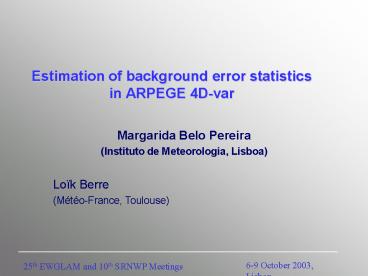Estimation of background error statistics in ARPEGE 4D-var - PowerPoint PPT Presentation
Title:
Estimation of background error statistics in ARPEGE 4D-var
Description:
Ensemble with five 4D-VAR. cycles of the non-stretched. version of ARPEGE model ... On operational ARPEGE 4D-VAR, the vertical profiles of total standard deviation ... – PowerPoint PPT presentation
Number of Views:23
Avg rating:3.0/5.0
Title: Estimation of background error statistics in ARPEGE 4D-var
1
Estimation of background error statistics in
ARPEGE 4D-var
- Margarida Belo Pereira
- (Instituto de Meteorologia, Lisboa)
Loïk Berre (Météo-France, Toulouse)
2
Importance of background error estimative
- - The analysis field results from a combination
of - observations and background (short range
forecast) - - The weights given to the observations and to
the - background depend on error statistics
- - The background errors statistics determines the
way - as the information from observations is spread
spatially - - How to estimate the background error statistics?
3
NMC method (operational in ARPEGE 4D-VAR)
Forecast error
Analysis error
4
Alternative to NMC method?
Ensemble Analysis Method
- Experiments
- Ensemble with five 4D-VAR
- cycles of the non-stretched
- version of ARPEGE model
- with T299 and 41 levels
- Period
- 1 of February to 24 of March
- of 2002
Random numbers (5) observations
Perturbed observations (5)
Background differences-gtB
Perturbed background (5)
Data assimilation
Perturbed analysis (5)
6h forecast
5
Standard deviation (normalized) of vorticity
background error Ensemble Method
Level 21 (500hPa)
Truncation T42
Level 32 (850hPa)
6
Impact of geographical variation of standard
deviation of background errors
Geopotential (anomaly correlation)
Forecast against ECMWF analysis
Forecast against observations
7
Impact of geographical variation of standard
deviation of background errors
Wind speed (anomaly correlation)
Forecast against ECMWF analysis
Forecast against observations
8
Ensemble Method versus NMC Method
- Spectral Space
9
Spectra of vorticity background error
Ensemble Method the errors for the wind field
have a bigger contribution from the mesoscale and
subsynoptic scales than with the NMC method
Ensemble method
This result is valid also for the other
variables, except for divergence
10
How to estimate the length scale of
autocorrelation function?
Which assumptions are made?
Background error covariances are assumed to be
- stationary
- spatially homogeneous
- isotropic (horizontal length scale doesnt
depend on direction)
autocorrelation function
Definition of length scale (L) of the
autocorrelation function (Daley, 1991) for the
one-dimensional case
L is a measure of the inverse curvature of the
autocorrelation function at the origin
For a sharp autocorrelation function, the
curvature is large, so L is small. So, L gives an
idea about how the autocorrelation function
decays with distance, from its initial value. In
pratice, L is a measure of the influence radius
of one observation.
11
Autocorrelation of background errors
The autocorrelation tends to zero faster in
Ensemble method than in NMC method
Surface pressure
Length scale of autocorrelation
Length scale of background errors are smaller in
Ensemble method than in NMC method
The length scale of vorticity is smaller than
the one of temperature, this difference is
smaller in Ensemble method than in NMC method
12
North-South variation of vertical correlation of
background error
Temperature
Vorticity
13
Vertical profile of standard deviation of
background error
On operational ARPEGE 4D-VAR, the vertical
profiles of total standard deviation of the
background errors are rescaled by a factor of 0.9
to account for mismatch between the magnitudes of
the 12/36-hours forecast differences and the
6-hour forecast errors
To use the statistics from Ensemble Method it is
need to rescale the vertical profile?
what is the best factor?
1.5 (green curve)
14
Impact of background covariances estimated by
Ensemble method (against NMC method)
Forecast against ECMWF analysis
Geopotential
Wind
15
Autocorrelation function in gridpoint space
Isotropic Lx Ly
Lx lt Ly
Lx gt Ly
o
OR
16
Length scale of autocorrelation
autocorrelation
Covariance of stream function gt
standard deviation of background error
Helmholtzs theorem gt
Rotational component of meridional wind
Covariance of v between 2 points gt
Zonal length scale of autocorrelation gt
Meridional length scale of autocorrelation gt
17
Ensemble Method versus NMC Method
- Gridpoint Space
Length scale of autocorrelation
18
Horizontal length scale of vorticity
Lx
Ly
Ensemble LAND
NMC SEA
Ensemble SEA
Lx
Ly
Ensemble EURATL
NMC SEA
Ly is larger than Lx, this difference is larger
in EURATL region
Ensemble GLOBAL
NMC EURATL
19
Lx is smaller over land than over sea, mainly in
Ensemble method
Horizontal length scale of temperature
Lx
Ly
Both Lx and Ly in Ensemble method are smaller
than in NMC method
Horizontal length scale of geopotential
Lx
Ly
Ly is larger than Lx, also for temperature and
geopotential
20
LAND
SEA
Horizontal length scale of wind (Zonal and
meridional length scale of zonal and meridional
wind)
Lx (u) gt Ly(u), except in PBL
Lx (v)
u is more anisotropic over sea than over land,
except near surface
Ensemble Method
Ly (v)
Lx (u)
EURATL
u is more isotropic in EURATL region
Ly (v) gt Lx(v), mainly in EURATL region gt v is
more anisotropic in this region
21
North-South variation of horizontal length scale
of wind background error
Lx(u) and Lx (v) in Ensemble method are smaller
than in NMC method and both are larger in the
tropics
Lx(u) is larger than Lx (v) in both method
22
Conclusions
- In Ensemble method the length scale of
autocorrelation is shorter than in NMC method - This difference has a positive impact on
forecasts - The meridional length scale is larger than the
zonal length scale for all variables, except
zonal wind - The meridional length scale is more homogeneous
than the zonal length scale - The zonal length scale is larger over the tropics































